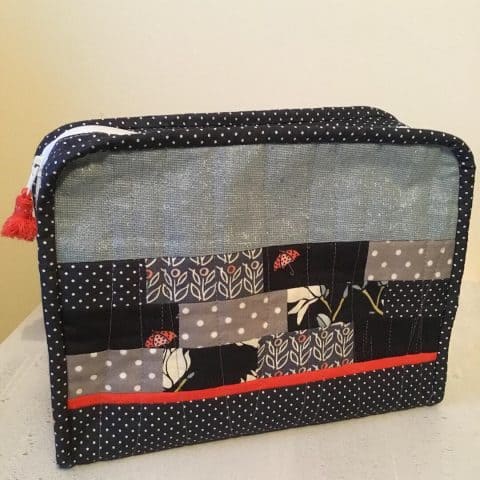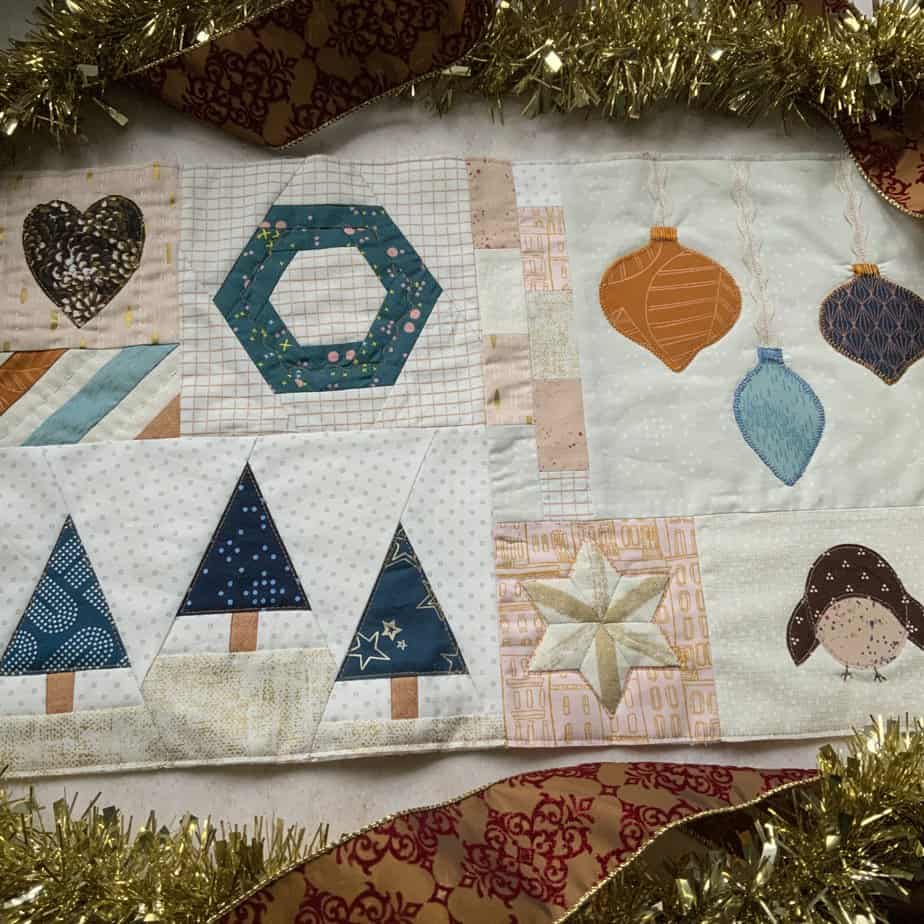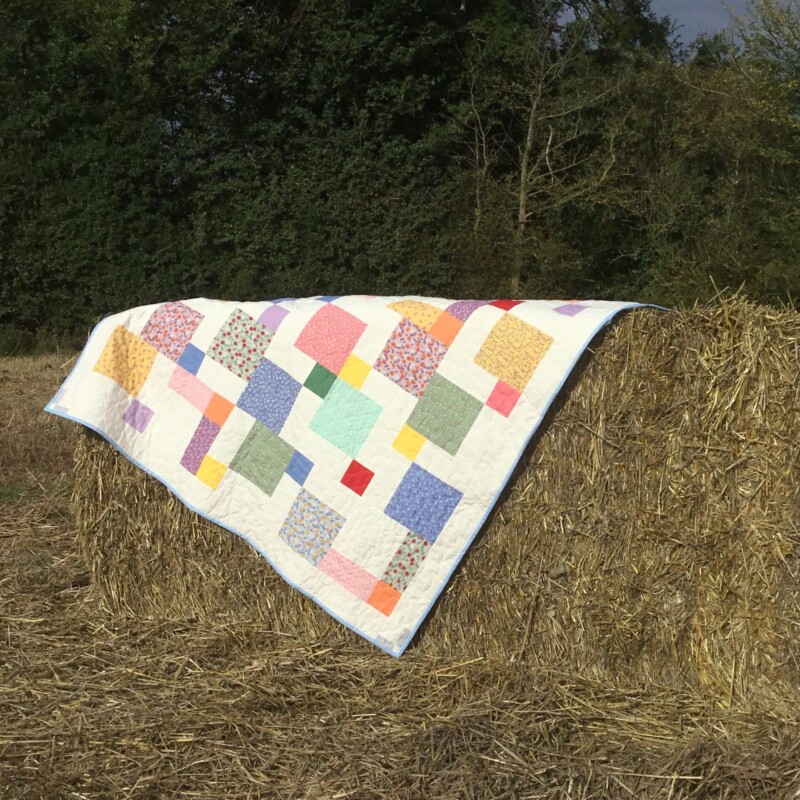#QuiltingTheory – Seam Allowance
Helloooo! And welcome back to Week 2 of the #QuiltingTheory series. Today, we’re looking at the Seam Allowance. This may be a term that you’re already aware of – especially if you’ve done some sewing before. One of the main things to know is that as quilters, we nearly always work in Inches (in comparison to dressmakers, who tend to work in centimetres), no matter what country you’re from! Which can then get a bit confusing when you’re ordering fabric in metres….but I digress!

Table of Contents
What is a Seam Allowance?
Simply put, a seam allowance is
When I first started quilting, I worked out a 1/4″ on my sewing machine foot and off I went. All went well to start with: strictly speaking, if you’re sewing squares together, it doesn’t matter if your seam allowance is a smidge bigger/smaller than 1/4″: if you’re using the same allowance on all pieces of fabric, you will still end up with a square!
Sewing a 1/4″ Seam Allowance
There are a few ways to figure out how to sew a 1/4″ seam allowance on your sewing machine.

Sewing machines often come with a few different sewing feet. A ‘standard’ foot (which is the ‘A’ foot on my Janome, pictured on the left) is included with all machines, and sometimes you may receive a 1/4″ foot depending on what machine you have (the ‘O’ foot, pictured on the left). These can often be bought separately which is useful if you enjoy quilting – just make sure that it’s compatible with your machine!
There are a few ways to find out what to use as a guide mark for achieving your 1/4″ seam allowance, and these can be used for both types of sewing feet, although here I have only demonstrated with the standard foot;
- Look at the measurement marks on the bed of your sewing machine and keep the edge of the fabric in line with this as you sew.
- Place the foot on top of a ruler and look at where a 1/4″ measures from the centre of the foot – for my machine, that means keeping the edge of the fabric in line with the edge of the hole where the needle sits/the transparent section of the foot.
- Sit at your sewing machine, and with the needle in the down position and the foot on the bed of the sewing machine, place a ruler (I’ve used this one!) matching the 1/4″ against the needle and look at where ‘0’ is on your sewing foot.
Personally, I like to measure from the needle position as I’ve found that every machine I’ve had is slightly different and the 1/4″ isn’t quite as accurate as I would like! Generally speaking, with the Janome a 1/4″ is at the intersection of the transparent/metal join at the front of the foot.
What is a scant 1/4 seam allowance?
To sew with a scant 1/4″ essentially means to sew the seam slightly less than 1/4″ from the edge of the fabric, so that the thickness of the thread and the little bit of fabric that is lost in the fold when opening the pieces out takes the total seam allowance up to 1/4″.

At this point, you are probably thinking quilters are crazy! We’re arguing over maybe the width of a piece of thread?!?! And I mean, how much difference can that really make?!
The honest answer is that it very much depends on what you are doing. If you’re sewing together squares of fabric until you reach a quilt size you like, you don’t need to worry about this just now!

However, if you are working on a block that is made up of lots of pieces, or working on a small block, seam accuracy really starts to matter.
A slight discrepancy of 1/32″ per piece/block can soon add to become a big issue: I once had to unpick a whole border round on a medallion quilt because it finished 3/4″ smaller than it should have done (I was working with small 1.25″ squares which is why it had such an impact!)……sooo frustrating, but all part of the learning curve. At least, that’s what I was trying to tell myself at the time!
Working out a Scant 1/4″ Allowance on your machine
We’ve already talked about how to find the 1/4″ position on your machine. For a scant allowance, you will need to sew slightly closer to the edge of the fabric, which can take a bit of trial and error. There are a couple of ways of doing this depending on your machine;
- Re-position the needle
- Re-position the fabric
If you can, repositioning the needle is easier than trying to realign the fabric by such a small amount, and easier to replicate time and again.
This will very much depend on whether you are able to shift the position of your needle. On my machine, which is digital, you can use the Width setting to shift the needle left or right by slight increments.
Some machines have a 1/4″ setting – for me, this automatically gives a needle position of 8.3. However, to get a scant seam allowance, I have to increase it to 8.8 (shifting the needle to the right as you look at the machine).
I make this change each time I switch my machine on, and it soon becomes

If you need to re-position the fabric, it can be helpful to mark the bed of the sewing machine – Washi Tape is a really good way of creating a guideline to follow without permanently damaging/marking your sewing machine, is easily replaced and relocated if swapping between projects. Although if you have a top-loading bobbin

The best way to check for a Scant 1/4″ Allowance is;
- Take three pieces of fabric 2.5″ square.
- Place two pieces Right Sides Together (RST) and sew along one side.
- Open out and place the final piece RST with one of the squares and sew so that you have a row of three squares stitched together.
- Press with the seams to one side and measure the centre square.
If it measures 2″ you have achieved a scant seam allowance. If it’s slightly under/over this measurement, reposition the fabric/needle as detailed above and repeat the steps above.
It may take a few attempts, but only needs to be done once (although I would always recommend re-doing these steps if you get a new machine) and is well worth the effort before embarking on a big, or small, project!
Some Exceptions!
As always, there are some occasions when you can/need to use something different to a 1/4″ seam allowance (scant or otherwise!);
- English Paper Piecing (EPP): some quilters prefer to use a bigger seam allowance – generally 3/8″ – when wrapping fabric around paper shapes. This can make it easier to prepare the pieces and allows for the fraying that can occur with the handling of fabric over time but is very much down to personal preference.
- Basting: If making accessories eg. a pouch, you may need to join two (or more) pieces of fabric temporarily. This is done by using a longer stitch on the machine – or hand stitching – normally within the seam allowance eg. at 1/8″
- Pattern: although most patterns use common abbreviations and techniques, I would always recommend reading through a pattern before starting a project to make sure that you understand all the standard definitions and seam allowances that the designer recommends.
And that’s all for Seam Allowance! I hope it’s helpful for you in your sewing journey? If you have any questions then let me know and come back next week when we’ll be looking at fabric. I’ll try not to get too lost in my stash over the coming week whilst I’m doing some research…..!!!!!!
To see all the other posts in this series, you can see the schedule here;
- Introduction to #QuiltingTheory
- Week 1 – Quilting Lingo
- Week 2 – Seam Allowance
- Week 3 – Fabric
- Week 4 – Essential Tools
- Week 5 – How a quilt is put together
See you soon,
S
Today’s sky::: overcast, grey. Generally miserable. Meh!
If you would like monthly news and updates, please sign-up to my newsletter.
To check out my quilt and accessories patterns, visit my Pattern shop.
For my favourite sewing equipment and tools, visit my Amazon store.










